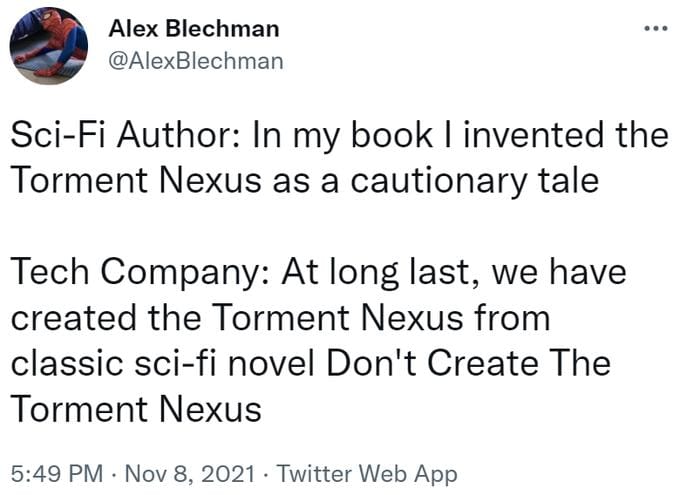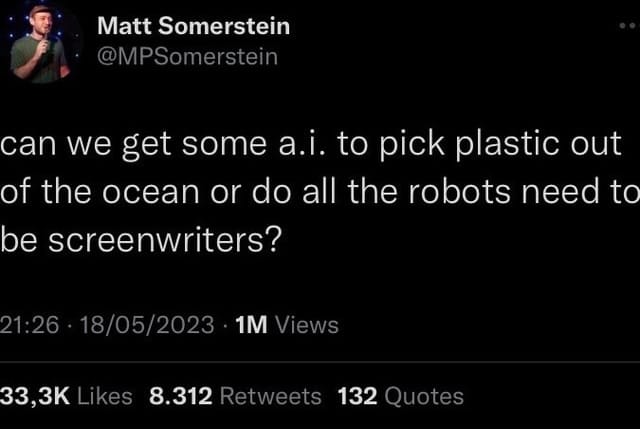4. Start miming. Just do a whole performance as a mime stuck in a box. Then ask "can AI do THAT?"
The post Things To Do When Your Family Tries To Talk To You About AI This Holiday Season appeared first on Autostraddle.
4. Start miming. Just do a whole performance as a mime stuck in a box. Then ask "can AI do THAT?"
The post Things To Do When Your Family Tries To Talk To You About AI This Holiday Season appeared first on Autostraddle.
Laura Wellington is estranged from one of her adult daughters. The Connecticut 59-year-old is somewhat famous for this, in fact, or anyway famous for her response to it. Across Tiktok and Instagram, under the name "Doormat Mom," Wellington's railing against the supposed injustice done to her by a daughter she calls an "ungrateful little bastard" has brought her some 140,000 total followers. This past weekend she was one of the subjects of a Wall Street Journal article reporting on what the writer Elizabeth Bernstein calls a "movement" aiming to "reduce stigma, build community, and empower others who are enduring one of life's most painful experiences: the loss of a child who is still alive."
From the Journal article, a reader can learn that Wellington, who regards herself as a good mom, reportedly initiated the estrangement herself, after learning she wouldn't be invited to her daughter's wedding. You can learn that Wellington, in addition to her dedicated Tiktok and Instagram accounts, also has launched Facebook and YouTube accounts, a podcast, and a self-published book, all themed around the supposed phenomenon of parents being unjustly cut off by their cruel adult children. You can certainly, on the basis of these facts, start to form a pretty good idea of what kind of person Laura Wellington is, and, say, what it might be like to encounter her as a worker in a retail or customer service job.



What's the opposite of a lazy person? Whatever it is, I can't call myself that. I won't self-deprecate so I don't call myself lazy, either. But if there's a spectrum, I'm closer to lounge-on-the-couch than organize-a-5K. As a small-business owner, I'm always looking for ways to supercharge my work. Most of my clients don't have endless supplies of cash. I try to deliver as much as I can within their budget. What's more, I can't be an expert on everything. I will always have a few things I have to outsource to someone who is more knowledgeable than me. So when the hype of AI hit the consulting world, it should've been an easy decision for me to jump on board. Instead, I watched with a mix of curiosity and horror as it burrowed into every part of the american economy.
Rachel Kacenjar at Work in Progress Consulting saw this wave coming. Back in September, Work in Progress published an AI Policy for their work. Even a few months ago I wasn't sure I needed a policy for my business. I thought I could skate past AI like I had other fads: NFTs, Labubus (Labubi?), and blockchains. Harvard economist Jason Furman making news recently changed that for me. He calculated that 92% of GDP growth in america in the first half of 2025 was due to AI investments. No matter what happens to it in the future, that much money doesn't evaporate overnight. Except for NFTs—wow, what a tumble they had, huh?
I set out to write my own AI policy. I realized that I only really knew the edges of what I was trying to achieve. Would a blanket policy work for all the ways that AI is infiltrating our lives? Would clients care about the stance that I took against it? If AI reached a critical mass with my consultant colleagues, could I afford to be in open rebellion against it? As in everything I try to do, before I could take a stand on AI, I needed to seek to understand it.
@talentagencyguide Ethan Hawke says that he's "bored by Al," saying he prefers real human connection. He calls Al a "plagiarizing mechanism" and jokes that while he knows it's changing the world, he's in "open rebellion" against it. #ai #acting #theatre #actor #actress ♬ original sound - talentagencyguide
I knew before I started working on this essay that "AI" is not one thing. There's a lot of hype out there that takes advantage of this. The AI that people are using today is not the same version that executives sell to shareholders. Even within the umbrella of real-world AI lies many different models and functions. I created the summary below with guides from IBM and Sully Perella from Schellman.
Narrow or Weak AI. This is the type of AI we have now. Every type of AI that exists today fits within this broad category. This type of AI can perform tasks that someone asks it to. Someone has to write the instructions beforehand. Weak AI can't do new tasks based on what it already knows. Reactive Machine AI can perform the same task over and over but can't learn from what it's done. One example of Reactive Machine AI is Deep Blue, IBM’s chess-playing program. It can calculate the most probable chess move out of millions of options, but it is terrible at Jeopardy. (It was IBM’s Watson that played Jeopardy). Limited Memory AI can remember things it has said or done. Google's Gemini AI can hold on to conversation details for a while before forgetting them. It was also pretty full of self-loathing (relatable) before a software update fixed that (unrelatable).
Strong AI or Artificial General Intelligence (AGI). This type of AI doesn't exist, but everyone with money wishes it did. This AI can go beyond Narrow AI to complete tasks that nobody programmed it to do. It learns and responds to stimuli; modifies its own code, more or less. Over time, it could have about the same cognition as a human.
Super AI. This is about as science fiction as we can get. Super AI combines human reasoning with lightning-fast processing time. It can learn, respond, and direct itself to do things based on what it learns. This is basically Skynet if you're a Terminator fan. It's the kind of dream for anyone who would get excited by a torment nexus.

Within the umbrella of Weak AI is all the AI that we use today. But these distinctions are important to understanding the AI that’s around us.
Machine Learning. This is a type of AI trained to identify patterns in the data it receives. For most Machine Learning AI, it can learn over time the patterns that are legitimate and the ones that are not. My favorite example is the AI that can detect cancer tissue in scans earlier than humans can (more on that later).
Large Language Models (LLMs). This is a form of Machine Learning. Its speciality is interpreting and generating text. ChatGPT is the most famous example of an LLM. Its purpose is to mimic human speech and respond to what people say to it. It can translate languages and carry on a conversation. Others are the chatbots on every website and the autocomplete in emails and texts are LLMs. An LLM is what summarizes product reviews or scans PDFs without you needing it to. And the LLM Google Gemini is famous for suggesting that you glue your toppings to your pizza.
Generative AI (gen AI). This is the famous sibling, to be honest. Generative AI creates new images based on art and images it has scanned. It can create music based on styles and genres it trained on. And it can create new code based on the libraries of code it can already access. But it can’t invent new code and it doesn’t know how well it does at something. Sully Perella writes that this AI would learn how to be a chef by "reading books with favorite recipes.”
When people talk or write about AI today, it's likely that they mean one of these types. I find it important to know the difference between types of AI, what each can do, and what people are saying it can do. Now that I’ve parsed the differences in AI that I know of, I’ll share my misgivings with it.
Every form of AI today has similar environmental impacts. With every query, AI is running thousands of lines of code. AI software "lives" in data centers that house its programming. These data centers use a lot of energy to process these queries. It takes a lot of water to cool to processors so they don't overheat. This is draining the water supply in areas that don't have much to spare. Data centers have to choose between cooling with water and cooling with air conditioning. That makes their energy usage even worse. Michael Copley at NPR reports that one AI data center can use as much electricity as 100K households. Data centers now under construction will need the same amount of power as 2M households.
Data centers house more programs and services than AI alone. We've relied on them since the Internet exploded in the 1990s. But AI is driving a data center boom. AI-peddling companies need to build up a supply of processing power for the AI of the future. It's this future AI that is driving growth and investments. Power-hungry data centers keep cities from retiring their coal-burning power plants. It's behind the reopening of the Three Mile Island nuclear plant (the one that had a partial meltdown in 1979).

We already know enough about the environmental impacts of AI. Like everything else, Black and brown communities feel that harm the most. But the impact of AI on BIPOC communities goes beyond pollution.
Large Language Models amplify the biases that their creators instill in them. Grok, another model, calling itself MechaHitler is an extreme example of this. But jokes about robot Nazis at a company led by a human one can hide larger issues at stake.
Covert racism touches everything. It's what leads white people to quote MLK, Jr. while avoiding "sketchy" neighborhoods. Unfortunately, AI has inherited the biases of the society that built them. Hofmann, Kalluri, Jurafsky, and King studied the covert racism of LLMs. These LLMs treat people worse when they speak in African-American English (AAE) dialect. The authors found that AI depicted these users as, “more criminal, more working class, less educated, less comprehensible and less trustworthy when they used AAE rather than Standardized American English (SAE).” They asked 5 popular LLMs to pass sentencing decisions on hypothetical alleged murderers. The "defendants" submitted a statement to each LLM written with either AAE or SAE. Each model gave AAE-using defendants harsher sentences than people who spoke SAE. What's more, AI is more likely to mistranscribe or misunderstand AAE speakers. My own experience with the AI transcriber otter.ai backs this up. It struggles to transcribe the non-white names it hears, even when we spell names the same way they sound.
LLMs work by training on work that someone has already written. Chances are, that source material holds racial biases the AI then amplifies. The study authors write:
“we found substantial evidence for the existence of covert racio-linguistic stereotypes in language models. Our experiments show that these stereotypes are similar to the archaic human stereotypes about African Americans that existed before the civil rights movement, are even more negative than the most negative experimentally recorded human stereotypes about African Americans, and are both qualitatively and quantitatively different from the previously reported overt racial stereotypes in language models, indicating that they are a fundamentally different kind of bias. Finally, our analyses demonstrate that the detected stereotypes are inherently linked to AAE and its linguistic features.”
It's unfortunate that AI is somehow more biased than biased humans. But this AI is in software that's already in front of the public. It's integrated into features and decisions that are already in use. Even Machine Learning can be racist. Police arrested Robert Williams because of face recognition technology that falsely identified him. ICE now uses facial recognition software to decide if people on the street are citizens.
AI used in healthcare also shows significant bias. Insurance companies use algorithms to determine who should receive complex care. They wrote the algorithm to rank patients higher if the costs for their care were higher. But researchers found that Black patients were much sicker by the time they got complex care. Because Black patients spend less on healthcare, the algorithm didn't rank them high. Because of this, Black patients received complex care less often than white patients.
The problem in all these cases is not that AI is racist and humans are not. Instead, it's that AI is automatic and harder to correct. Most of us can't see or understand the code that makes up AI. We have to trust that coders will set aside the biases and prejudice they may not even know they have.
The power of decisions is another factor in the capabilities of AI. Sci-fi author Ted Chiang wrote about decisions being at the very heart of good (and by extension, bad) art.
He writes that art is about creation, and the act of creation is about making decisions. A novel or painting is the result of many decisions. What will this tree look like when we're done with it? How will this character's story arc twist in creative ways? How do we present something to audiences that is both familiar and alien? Every work of art is a collection of these decisions. An AI is capable of mimicking that. But AI itself doesn't know whether what it creates is art. It takes us, our human minds, to find meaning in that art and decide if it's worthwhile.
But by that definition, generative AI can create art with input from a human user. Chiang tells the story of film director Bennet Miller. Miller created gallery-worthy art using the gen AI program called Dall-E 2. He would write descriptive prompts and view what Dall-E 2 geneated. He would then input more prompts to tweak the art until it satisfied him. But the 20 pieces of Dall-E 2 art he exhibited took more than 100K images to create. As Chiang writes, Miller's experience is one that OpenAI and other companies want us to have. But they can't sell the fact that it could take thousands of tries to create something worth having. They depict their software as easy to use, creating blockbusters with just a few prompts. But Chiang believes that even as a tool for artists, generative AI makes a whole lot of chaff for scant wheat. “The selling point of generative A.I. is that these programs generate vastly more than you put into them, and that is precisely what prevents them from being effective tools for artists.”
I fear that AI is doing more than making dumb art. It's making us dumber, too. When AI summarizes articles or books, it saves us the time by reading the whole thing. Reading a book isn't about the rote receipt of information. We can't even trust the information: AI makes up details and events that never happened. AI companies say they'll never be able to fix the problem of AI hallucination. LLMs and generative AI will always get facts wrong.

When we use AI to create something for us, we become the editors. I recently interviewed for a contract grant writer role with a small non-profit. With confidence, I assured the executive director that I would never use AI in my work with them. "Oh, you're right, I never use it," she replied. "Well, I have AI write all my emails, but then I tweak it to sound better." AI shifts our role away from imagination and decisons-making and closer to discernment. What makes something feel well-written to us? Is editing an essay made by autocomplete much different than writing it ourselves? LLMs take a prompt and create the most probable string of words as its answer. It can't make a turn of phrase except by accident. And it isn't creating new works of art as much as it is blending many sources of art. Generative AI doesn't create millions of ideas and chooses the one it likes the best. We have to do that.
How is this different from having an employee you assign tasks to? When I ask a human to do something, they are using their experience and knowledge to make decisions. I can give them feedback and they'll improve upon it. They might even improve on my work or take it in a direction I didn't expect. AI can mimic this, but it will never come up with something it hasn't seen already.
When we do use AI, there is some proof that it makes us worse at our jobs. Computer scientists using AI believed that it made them 20% faster than if they worked without it. Instead, they were spending 19% more time on a project with the help of AI. Paul Hsieh at Forbes wrote about another recent study published in the Lancet. They measured physicians' ability to detect polyps in a colonoscopy. When the doctors used AI, they detected slightly more polyps than doctors who weren't using it. But the difference between groups was slim: a less than 0.5% improvement. What's interesting is what happened after the physicians had gotten used to using AI. Physicians using AI that stopped using it suddenly got worse at detecting polyps. The study authors write, “continuous exposure to decision support systems such as AI might lead to the natural human tendency to over-rely on their recommendations.” While AI support might get better over time, we might be worse off if we ever choose not to use it.
My theory is that AI is a long-term project to limit or even end the human workforce under the guise of saving money. Thousands of people have already lost their jobs to some form of AI. One expert believes that right now AI could replace less than a third of the workforce. But the level of investment in AI is so high that I can't imagine companies would be willing to stop there. The american economy boomed during the 400+ years of Black enslavement and exploitation. Free land plus free labor drove the engine of our economy for centuries. Incarcerated laborers fill shelves with goods they make in american sweatshops. What if those manufacturers could give their shareholders a better quarter? What if they could push their labor costs closer and closer to zero? Wouldn't they claim it was their duty to do so? Is any human life worth more than a shareholder's dividend?
Bookstore giant Powell's in Portland, OR came under fire for putting AI art on their store merch. Powell's apologized after the AI slop hit the news. But the employees' union gave a statement that clarified Powell's knew all along. "If Powell’s leadership is truly ‘committed to keeping Powell’s designs rooted in creativity and imagination,’ we hope in the future they will be more receptive to feedback from their many creative and imaginative employees—among them, an enormously talented in-house design team." Portland is a city full of artists. I always find a mural, graffiti, or other art to admire when I'm there. Even when those artists work for Powell's, executives still prefer a non-human touch. If that's not a world we want to live in, we need to say so.

My mind has spent a lot of time on that concept of discernment. As a consultant, creativity is my bread and butter. I make a lot of decisions in my daily work: how to design a project; how to guide a focus group I lead; how to pivot in a workshop. How is that different from rewriting an AI-drafted email? Or having an LLM give me a list of icebreakers to choose from? One could argue that the difference is so small that most people won't notice.
In the two weeks it took me to write this, a startup announced it invented the world's first AGI-capable model. Nobody knows whether this is true, but it's likely that that day will come sometime in the future. Will the AGI be more capable than us? Will autonomous AGI or Super AGI robots take over our homes? For now, I see AI as a tool—one that may have real benefits, but not at the level of ubiquity it now enjoys.
I was talking with a colleague about AI policies several weeks ago now. "It's pointless to write one," she said. "AI is changing so fast that as soon as you do it'll be obsolete." She may be right. I'm still planning to write one—by hand. I know what a unique experience it is to be human. I'm not ready to give that up yet.
I will share be the future/Future Emergent's AI Policy in a January blog post.

This week’s question comes to us anonymously:
How do you lovingly care for an aging parent who treated you like shit?
This question has been sitting in my inbox for almost two years. While I fear that I’ve waited too long to possibly help the person who asked it—for which I am sorry—I had to wait until I was ready to answer it. That day is today.
I’m currently on a flight to Lisbon to bury my father. The call came on Thursday morning, or rather there was a text. A text from my Aunt in Portugal telling me about funeral arrangements.
“Funeral arrangements for who?!”
There is a photo of my father somewhere (perhaps only in my memory of this point) where my father is sitting cross-legged on the floor of my parents’ first apartment in the United States. There’s a Christmas tree behind him (yes, this is a Christmas newsletter). The tree is foil or aluminum or whatever those old 70s trees were made of. A few feet away there’s a rotating color wheel that changed the tree different colors. He’s smiling. He’s got a 70s mustache that matches the tree. I have a vague memory of a thick white cableknit sweater. Philadelphia is cold.
My parents immigrated to the United States when I was two years old. They moved to Philadelphia because people in small towns tend to immigrate to the same place. A community is displaced, and then rebuilds itself in a new place. And folks immigrating from the small town my parents were from all immigrated to Philadelphia. I’m guessing someone was first, but since the history of the Portuguese in the New World doesn’t tend to reveal good things, I never went looking.
I’m guessing this photo would’ve been taken during their first Christmas here, which would’ve happened after they’d been here almost a year, since we immigrated in January. Although I’ve always been tentative about using the verb immigrated for myself. I was two. I’m an immigrant, but I never really immigrated. I was luggage. (I’m willfully omitting my younger brother from this story because although he is also an immigrant he voted for a man who kidnaps immigrants, and I am petty. I get to be petty today. I am erasing him.)
Going back to the photo, as I rotate the scene—which it occurs to me I’m doing for the first time right now, never having given it a thought—I’m picturing my mother with a camera in hand. Some form a cheap Kodak 135 instamatic with a rotating cube flash (I have a vague memory of it). I imagine that she’s smiling back at my father, and it occurs to me that they didn’t smile at each other too often. Certainly not recently. But this photo is possibly evidence that they once did. I wonder what their first year in a new country was like. I’m sure it was frightening at times, but this photo—which is now most likely lost—is evidence that maybe, just maybe, for a brief moment they might’ve smiled at each other more, and possibly even loved one another.
I’m currently on a flight to Lisbon to bury my father, who once bought a foil or aluminum or whatever it’s made of Christmas tree in Philadelphia and brought it home, to a shitty third floor walk-up, and set it up and then sat cross-legged on the floor in front of it, smiling at my mother while she took his picture and I am so so so fucking mad that man is dead, but that man died a long long time ago. And I am even madder about that. I am so fucking angry at you for not staying that person for longer than that moment. That one fucking moment that I have to hold so close because you gave us so few of them.
And now I’m crying on a flight, and I am angry at myself because you do not deserve it. I want to put a stranger in the ground, but try as I might, you refuse to be that. Because there were moments that gave me hope. Moments that made me realize you were capable of more. I honestly tried so hard to get more of those moments out of you, and I hate you for withholding them.
(This is an eleven hour flight, and I’ve slipped into the second person. I pity my readers this week. You are well and truly fucked.)
Speaking of which; the last thing my father told me was to go fuck myself. This happened on the phone a few years ago, during a call with my mother. I heard her turn away from the phone and ask him if he wanted to say hello. I heard him reply in the background. Tell him to go fuck himself. And that was that.
Death does not make saints, and I have neither the desire nor the power for beatification tonight.
My father has died many times (although this current death seems particularly final). There is a particularly brutal death in the death of hope. The moment you realize that there won’t be a reconciliation, that the moment movies have taught us is possible, when an aging parent and a wayward offspring (they will always see me as wayward) come to an understanding, when the mistakes of the past are laid out for sifting through, and the clouds—both real and metaphorical—part, and they see you as you are and you see them as they are, and there’s a big cry. Followed by apologies, promises to do better, and possibly a shared tapioca at the home where that parent is living out their last days. And those movies generally end with the offspring and an underwritten but supportive spouse standing in front of a fresh grave so the offspring has someone to turn to and say “I’m glad I finally got to know him” before the credits roll and everyone immediately calls their mother.
That moment doesn’t happen in real life. There is only the brutal awareness that time is slipping away and any hope of reconciliation, any hope of asking about that Christmas photo slips away with it. And that is brutal, but generally how it happens. Life isn’t written according to the rules of magical realism. There is only time, and time begets death. And it’s on us to work those two ingredients into a life that matters. To live it in such a way that our life is filled with love, and to live it in such a way that we become intertwined with other lives that we can fill with love and they, in turn, replenish our own lives with love. And if we manage to do this close-to-right (because perfectly is impossible), death is earned in a way that what we leave behind weighs more than what we put in the ground.
Graves are heavy things when we end up burying hope along with bodies.
There is another memory, in another apartment (there were many apartments, we moved almost yearly), and there are three of us now. (I have little to say about my youngest brother as well.) I don’t remember what particular mistake this was atoning for, but my father told us all to get in the car. He drove us to Sears on Roosevelt Boulevard, which is long gone, and told us to pick out baseball equipment. We thought this was odd because he’d never shown an interest in baseball, and I’m not sure any of us had either at that point. But we picked out gloves, a couple of balls, and an aluminum bat. I also remember that we bought Baltimore Orioles caps, which sticks with me because I’m not sure why a department store in Philadelphia would’ve had these in stock, but we most likely chose them because there was a cartoon bird on the cap, and we liked cartoons. He then drove us out to a park where he attempted to play baseball with us, which none of us could do. And I remember as his rage grew with every errant throw, and every missed catch, and every whiff of the bat, and I remember a slap, and I remember all the baseball equipment ending up in a trash can on the way to the car. I remember a silent ride home. I can’t remember if he came home with us, or if he angrily dropped us off. Most likely it was the latter, because I’m playing the odds.
As time stretched away from the moment when that first Christmas photo was taken, home became less of a place where my parents would take smiling photos of each other and more of a place where he would stash the family he had grown to regret.
The baseball story is a recurring theme with my father. The big moment that was supposed to make up for a thousand little missed moments. The large gesture that, in his mind, made all the kicks and slaps—and later, punches—something that could be brushed under the table. And even then, the big moment ended with a return to form.
Children are not made for big moments. They cannot hold them. We didn’t want baseball equipment, we wanted him to smile when he looked at us. We wanted him—as stupidly cliché as it is—to tell us that he was proud of us. And since we’ve jumped into the cliché pool and we’re already wet—yes, I am flying to bury a man who never told me he loved me. But I say with with some amount of certainty, all children are born ready to love their parents. It takes a lot to push that away, and now that I’m a father myself I cannot imagine why someone would push away this amazing thing, this love, this thing that helps to keep me alive. And now I’m crying, not because of him but because I am thinking of my daughter, and how amazing it feels to hug her and tell her that I love her, and to know that she loves me back, and that we have a relationship of small moments. Moments that can be held in our hearts, but also moments that we know we don’t have to cherish like a lost half-century old photograph because our moments are abundant. I cannot wait to hug my daughter again, and to tell her I love her. But to do that I have to bury my father.
Sometimes, to raise our children we have to bury our fathers multiple times. And here I will finally begin to answer your question: How do you lovingly care for an aging parent who treated you like shit? And look, I’ll be straight up and tell you that I had no idea where this was going when I started, but it revealed itself. You loving care for an aging parent by protecting his grandchildren from his sins. You lovingly care for an aging parent by making sure that the way they treated you stops with you. You lovingly care for an aging parent by learning how to love others, and by letting them love you. You lovingly care for an aging parent by digging multiple graves, the first one for their sins, and the second one for their body. As my therapist likes to remind me, my father hurt me because most likely someone hurt him. And while that doesn’t make it ok, it does contain the key on how to stop a cycle that doubtlessly has been running full steam in my family for generations.
And that cycle is over, as least as far as one of three sons is concerned. (I fear it will continue for the other two.)
Which explains why I’m on this flight, getting closer to his body with every word I type. It’s not because I believe in closure. It’s because I need to prove to myself that the man who raised me didn’t break me. That even though he didn’t teach me the right thing, I have learned what the right thing is. And it took some fucking work, man. And I am putting him in the ground in the same cemetary where generations of my ancestors have been put in the ground. And somehow, I need to let these ghosts, all these wretched ghosts that are expecting me in their genetic haunting ground, know that I won’t be joining them. This is the last of our dead we’ll put in this ground. We are done. A new cycle is starting, a cycle of small moments. A cycle where a child’s love is rewarded, and appreciated, and returned in kind. A cycle where we hold each others’ hands, and laugh at each other’s jokes, and fill each other with joy. And love.
I was hoping to end this with the realization that, despite it all, I loved my father. And maybe I do, I’m still not sure. But I can say, without any doubt at all, that I wanted to. Man, I really wanted to. It was there for the taking. All he had to do was reach out. I’m truly sorry he didn’t.
I think I would’ve been a good son.
❤️🩹 Thank you for making it to the end. This one was hard, and holy shit… I bet there’s a part two for the flight back! Buckle up, because Mom’s on the ground is she’s gonna want some stage time!
🖐️ Got a question? Ask it! You too can get a feel-good reply like this one.
🍉 Please donate to the Palestinian Children’s Relief Fund. They’ve lost so much more than most of us can even fathom.
🏳️⚧️ Please donate to Trans Lifeline, and for fuck sake, if there is a trans kid in your life please love them. They are so so so so ready to love you back.

Quitting Spotify might have almost beaten Luke, but I’ve fared a little better thanks to my brand new digital audio player
Before there was the iPod, there was the cheap MP3 player. I remember these devices from my teenagerhood. Small and with barely a UI to speak of, they had robust storage and could hold hundreds upon hundreds of songs. Of course, the design improvements of the iPod would put all these also-rans out of business—it turns out that being able to access any song on your device within three clicks of that scroll wheel was an incredible boon for those of us with huge music libraries. From there the chain of history is easy to link together. The iPod leads to the iPhone leading to no one ever needing to have a standalone music playing device because they’re all subscribing to services like Spotify.
Because I have a lot of friends who are working musicians, I have absolutely no love for Spotify. They pay artists peanuts and they also make the music sound like shit due all the compression necessary for streaming audio to your device over the internet. I listen to tons of music, and have especially been interested in the dungeon synth scene, a very small scene of very small artists. While almost all the music I want is available streaming, I’d rather buy the music on Bandcamp, knowing that a higher percentage of my money goes to the artist—especially from artists who I know won’t make much money from streaming.
Up until I bought a Digital Audio Player, those Bandcamp purchases were largely theoretical. Sure, I’d bought the album, but I never downloaded the audio files, instead opting to listen to my music either on the Bandcamp app or on Tidal. Because Tidal also offers its listeners basically all music ever recorded in human history, that meant I wasn’t listening to the music I bought. A digital audio player forces my hand—and I’ve found that I genuinely enjoy this experience of listening to music a lot more.
While there is a fascinating world of people buying and refurbishing old iPods, when I looked at the broad price range and options for the wide variety of DAPs, I wanted to try something new. While I don’t think any device on the market holds a candle to the classic iPod, design-wise, I am extremely happy with my Snowsky Fiio Echo Mini.

What attracted me to the Echo Mini was that it doesn’t have any features I didn’t want and also that it is adorable. If you’re looking into the world of DAPs, it’s easy to get overwhelmed by choice. There are extremely expensive DAPs from companies like Sony that can also access the internet and download apps like the iPod Touch of yesteryear. But I don’t want any of that shit. I don’t even want Bluetooth. I want an object that plays MP3s that I listen to with my new wired in-ear monitors.
The Echo Mini is shaped like a tape deck and is even smaller than I expected when I grabbed it. For under a hundred dollars, this device can hold more music that I can reasonably listen to, even on my five hour Thanksgiving flight to Los Angeles. Because the Echo Mini has both onboard storage and a slot for a micro SD card, I have 256GB of storage and I’ve barely scratched the surface. The battery life is also remarkable, especially compared to my phone, which was previously my main music listening device. I haven’t had to charge it once since I bought it about a month ago.
Although the user experience leaves something to be desired—you’re forced to scroll through nested menus with multiple tiny buttons, reminding me of playing a Japanese RPG on the Playstation, complete menu hell—I love using this device. It slips right in my pocket and it frees me from the yoke of always looking for my phone when I’m out and about. Its clunky UI actually forces me to pick an album and stick with it, where having access to the entirety of all recorded music in history often gave me choice paralysis. It’s also revealed that if I make sure I have a couple of my comfort albums—how i’m feeling now, The Downward Spiral, a handful of Talking Heads albums—I don’t actually need to have access to every album ever. I appreciate the albums I have already bought so much more when I don’t have a choice but to listen to them.
But most of all—the music sounds amazing. I haven’t even dived into the alternate file formats like FLAC, and I’m already hearing new details in songs I’ve listened to over and over. Rosalia’s most recent album LUX sounds fantastic, surrounding me with the lushness of the orchestral compositions. Even pop music sounds a lot fuller. I was listening to the Dev Lemons album Surface Tension, and you can hear intonations from her deep in the mix that I simply cannot hear on streaming services.
After a month of using a DAP I can envision a future where I totally ditch streaming. Listening to albums purposefully, instead of just through the convenience of having literally everything available at all times, has allowed me to fall back in love with the music I have. I think there should be a little more friction in life, in general, but the friction of needing to actually buy an album was something I didn’t even realize I missed.